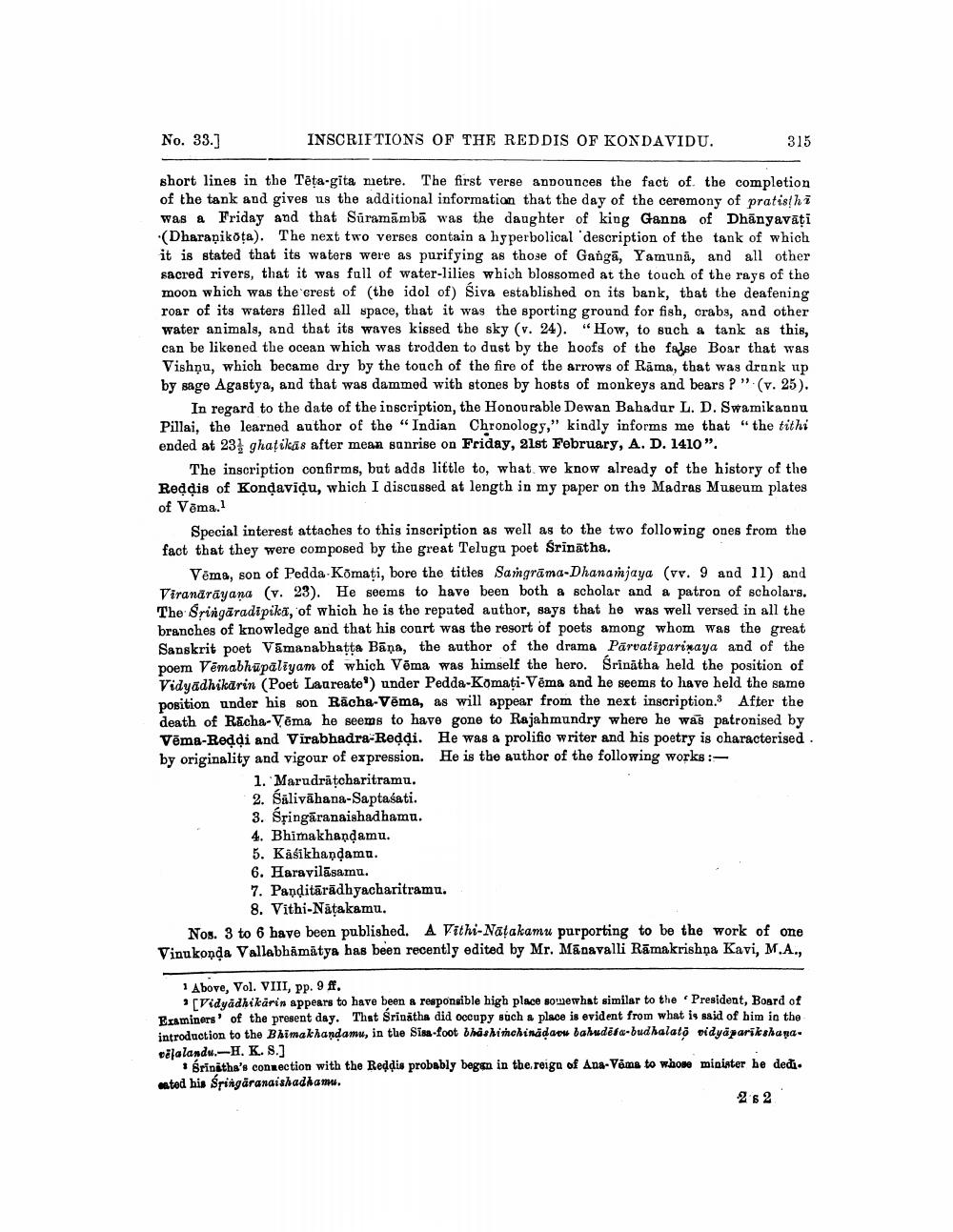________________
No. 33.]
INSCRIFTIONS OF THE REDDIS OF KONDAVIDU.
315
short lines in the Tēta-gita metre. The first verse andounces the fact of the completion of the tank and gives us the additional information that the day of the ceremony of pratishi was a Friday and that Suramāmbā was the daughter of king Ganna of Dhānyavāți (Dharapikota). The next two verses contain a hyperbolical 'description of the tank of which it is stated that its waters were as purifying as those of Gangā, Yamuna, and all other sacred rivers, that it was full of water-lilies which blossomed at the touch of the rays of the moon which was the crest of the idol of) Siva established on its bank, that the deafening roar of its waters filled all space, that it was the sporting ground for fish, crabs, and other water animals, and that its waves kissed the sky (v. 24). "How, to such a tank as this, can be likened the ocean which was trodden to dust by the hoofs of the false Boar that was Vishņu, which became dry by the touch of the fire of the arrows of Rāma, that was drank up by sage Agastya, and that was dammed with stones by hosts of monkeys and bears?" (v. 25).
In regard to the date of the inscription, the Honourable Dewan Bahadur L. D. Swamikannu Pillai, the learned author of the "Indian Chronology," kindly informs me that "the tithi ended at 23 ghatikas after mean sanrise on Friday, 21st February, A. D. 1410".
The inscription confirms, but adds little to, what we know already of the history of the Reddis of Kondavidu, which I discussed at length in my paper on the Madras Museum plates of Vēma.
Special interest attaches to this inscription as well as to the two following ones from the fact that they were composed by the great Telugu poet Srinatha.
Vēma, son of Pedda-Komati, bore the titles Samgrāma-Dhanamjaya (vv. 9 and 11) and Viranārāyana (v. 23). He seems to have been both & scholar and a patron of scholars. The Sringāradipika, of which he is the repated author, says that he was well versed in all the branches of knowledge and that his court was the resort of poets among whom was the great Sanskrit poet Vamanabhatta Bāna, the author of the drama Parvatiparinaya and of the poem Vēmabhupaliyam of which Vēma was himself the hero. Srinatha held the position of Vidyadhikarin (Poet Laureate') under Pedda-Komati-Vēma and he seems to have held the same position under his son Rācha-Vēma, as will appear from the next inscription. After the death of Racha-Vēma he seems to have gone to Rajahmundry where he was patronised by Vēma-Reddi and Virabhadra-Reddi. He was a prolifio writer and his poetry is characterised. by originality and vigour of expression. He is the author of the following works :
1. Marudrātcharitramu. 2. Salivāhana-Saptaśati. 3. Spingāranaishadhamı. 4. Bhimakhandamu. 5. Kāśikhandamu. 6. Haravilāsamu. 7. Panditārādhyacharitramu.
8. Vithi-Natakamu. Nos. 3 to 6 have been published. A Vithi-Natakamu purporting to be the work of one Vinukonda Vallabhāmātya has been recently edited by Mr. Mānavalli Rāmakrishna Kavi, M.A.,
1 Above, Vol. VIII, pp. 9 ff.
Vidyadhikarin appears to have been a responsible high place somewhat similar to the President, Board of Escaminers' of the present day. That Srinatha did occupy such a place is evident from what is said of him in the introduction to the Bhimakhandamw, in the Sisa-foot bhashimchinädaou bahudéfa-budhalato vidyaparikshaga. pējalands.-H. K. S.]
# Srinitha's connection with the Reddis probably began in the reiga of Ana-Vôma to whose minister he deđi. osted his Sringaranaishadhamu.
262




